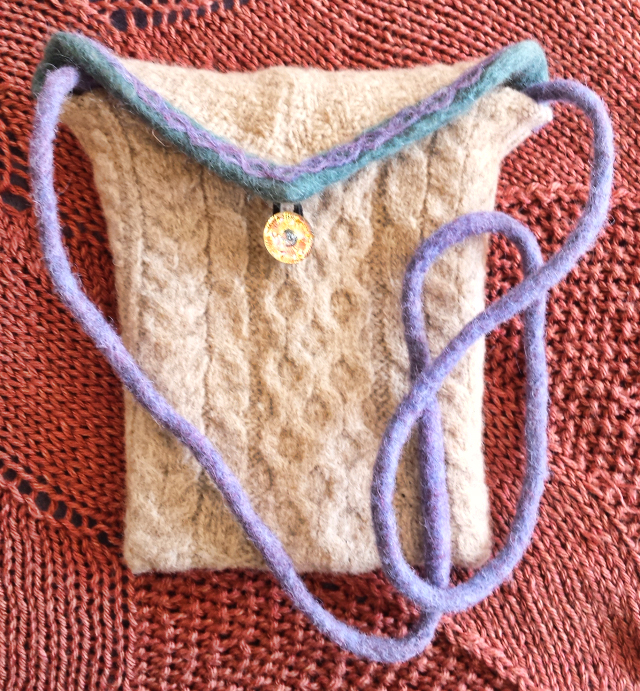I’ve been felting like crazy, feeding Wanda, my trusty l’il Wonder Washer machine, used wool sweaters as fast as I can find them at thrift stores!

Lessons learned: first, a felting fail. I couldn’t resist a soft sweater of gorgeous muted colors that violated the First Felting Rule: thou shalt not waste time and water trying to felt fabric that dost not have at least 50% wool fiber.

My fingers were crossed that the 20% wool plus 9% mohair would add up to enough, but nope. Hey, anyone want a beautiful very clean (as in, I ran Wanda about four times before I gave up) sweater?
Another lesson, that I guess is self-evident and I bet has some fancy scientific and/or metaphysical explanation: sweaters that are super-soft when unfelted, remain super-soft when felted. And itchy scratchy ‘I could never ever wear that’ sweaters? Oh yeah, after felting this 100% Shetland wool sweater, I’m not even sure what I can make out of it. Nothing that comes anywhere near anyone’s skin. Fantastic color though, and sturdy as, well, a Shetland sheep!
But on to my ode to soft. If you don’t know me in person I haven’t bored you with my phone pix of our crazy sweet kitty Frodo, and you have zero idea what the title of this blog article means. Frodey is incredibly soft on the scale of Persian down to scratchy short-hair alley cat …
And I’ve just felted some sweaters that I can’t stop petting as much as I do Frodo. The first photo up top in this article shows four sweaters I scored in one epic trip to my local Thrift Town. The purple argyle and two red sweaters are all 100% cashmere. Because there can be ethical problems with cashmere, I wouldn’t buy a garment or the yarn firsthand.
Most crazy soft, this unassuming short sleeved pullover. You can see how much felting shrunk it. Length always shrinks most, this one went from 21.25 to 14 inches! And width at shoulders: 12.75 to 10 inches.
Second softest, the other red, a touch more designerly with a long ribbed waist, which flared out after felting. Length: 21.75 to 12.75 inches; width at shoulders: 12.5 to 8.25 inches.
And a close third, the purple argyle. Interestingly the different colored fibers felted to slightly different degrees. Sometimes white or very light wool (also black) won’t felt at all, apparently due to a process used to achieve the color. This sweetie went from 22 to 12 inches in length, and 15 to 9.75 inches in width at shoulders.
You didn’t really think I’d let you go without a Frodo pic, did you?

Want to read more about felting fun? Click here to read my article Old Sweater, New Purse!















